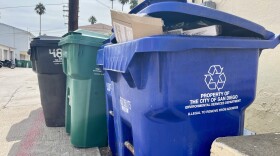When United States Immigration and Customs Enforcement (ICE) agents began arresting people in San Diego’s immigration court last month, local lawyers weren’t surprised.
“We had heard about this happening in other cities — we were just kind of waiting for our turn,” said Tracy Crowley, an immigration lawyer who rushed down to the Edward J. Schwartz federal building in downtown San Diego on May 22.
Crowley had been tipped off that morning by court observers with the group Detention Resistance. Approximately 20 ICE agents had showed up with a list of people with court hearings and began arresting them as they walked out of their courtroom.
Have a tip? 📨
The Investigations Team at KPBS holds powerful people and institutions accountable. But we can’t do it alone — we depend on tips from the public to point us in the right direction. There are two ways to contact the I-Team.
For general tips, you can send an email to investigations@kpbs.org.
If you need more security, you can send anonymous tips or share documents via our secure Signal account at 619-594-8177.
To learn more about how we use Signal and other privacy protections, click here.
These arrests are part of a broader tactic in the Trump administration’s mass deportation machine that funnels immigrants into a fast-track deportation where they have fewer legal protections than they do in immigration court proceedings, according to several lawyers and court observers who spoke to KPBS.
Crowley and other lawyers began offering pro-bono legal representation to immigrants on the ICE lists as they were being arrested. Crowley represented a Colombian man pursuing a political asylum claim.
“He had filed his asylum application, he had attended every single court hearing, he was doing things the right way,” she said.
ICE agents arrested that man. He is now being detained at the for-profit Otay Mesa Detention Facility.
Expedited removal
Ginger Jacobs is a local immigration lawyer with more than 20 years of experience. She said this is the first time she’s seen ICE use this strategy. Here’s how she describes it:
ICE lawyers, who function as prosecutors in immigration court, make a motion for the judge to terminate deportation proceedings.
“Normally, as an immigration attorney, you would think that’s a good thing, your client is out of deportation proceedings,” Jacobs said.
When a case is dismissed, it usually means the person can try to pursue other forms of legal relief to stay in the country.
But that’s not what’s happening now. After ICE lawyers in the courtroom dismiss someone’s case, ICE agents outside re-arrest that same person. Instead of opening another deportation proceeding, they place that person in expedited removal.
And as soon as immigrants are in expedited removal, they have fewer due process protections.
“It is a form of removal that does not involve a judge,” Jacobs said.
They don’t have access to legal representation or a chance to formally present evidence. Instead of a formal hearing by an impartial judge, they get an interview done by a Department of Homeland Security (DHS) employee, Jacobs added.
ICE agents have made similar courthouse arrests throughout the country — including in New York, Illinois, Texas, Florida and California.
ICE did not respond to a KPBS request for comment on the strategy.
Blocking the ICE strategy
Andreanna Sarkis is another local immigration lawyer. She said ICE agents tried to use the dismiss and re-arrest strategy on a client of hers who entered the country about a year ago.
“It seems that they’re targeting people who have been in the United States for under two years because they’re able to put them in expedited removal proceedings instead of waiting for the entire process to reach the end,” she said.
But Sarkis said she was wise to the tactic and blocked the motion.
However, while Sarkis saved the man from expedited removal, she didn’t save him from being detained. He’s now at the Otay Mesa Detention Center. And, like more than 80% of people held there, the man does not have a criminal record, Sarkis said.
“It makes the process a lot more complicated,” she said.
Representing a detained client is more difficult because of the amount of time and money involved, she added.
This means Sarkis has less time to prepare for hearings, speak with her client, and work on other cases. Also, the Otay Mesa Detention Center limits what lawyers can bring into the secure facility — including technology Sarkis uses for translation services. That means she has to bring (and pay for) a human translator to her visits.
Trump’s increased enforcement
Sarkis has noticed the Trump administration is making a “much stronger effort” to detain her clients — including those who attend all their court hearings and those who do not have a criminal record.
“Before, as long as my clients continued to appear in court and there wasn’t any reason to believe they were a risk to the community, they were able to come and go from court and live in the community,” she said. “Now it seems like detention is a priority for every client.”
Crowley hopes there is at least one silver lining to the Trump administration’s increasingly harsh tactics — that it makes it more difficult for the public to ignore the human impact of harsh enforcement tactics.
“I think people prefer this to be under the rug and outside their field of vision,” she said. “But now that it’s in their field of vision, maybe people will get behind comprehensive immigration reform that treats people with respect and dignity.”






